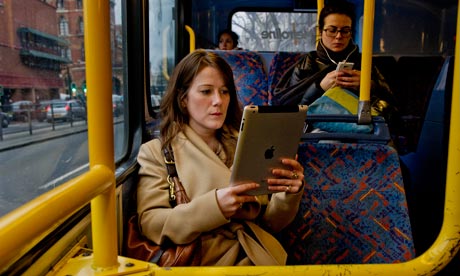Luxury craftsmanship and an eye for aesthetics are just the thing to give hardbacks an edge in their battle with ebooks
E-readers provide an easy option for people on the move. Photograph: Sarah Lee for the Guardian
Electronic time moves faster than real time. Just three years ago, the book world was having a collective nervous breakdown about "the future of the book". But now those fears are fading. Christmas 2011 was the all-time ebook holiday. Amazon reports worldwide sales of more than a million Kindles a week, with record demand led by its Kindle Fire tablet.
The immediate future of the book is clear. E (electronic) is for easy; P (print) is for posterity. Book readers today are leading double lives. We are faithful to our libraries at home, but stray towards the delights of digital the moment we board a plane, train or automobile.
The pleasures of E means downloading the new book we fancy, from reviews, word-of-mouth or plain curiosity. The satisfactions of P come from acquiring lovely print editions for our bookshelves. In due course, but not quite yet, the world's writers and their agents will work out how fully to monetise this double market.
One unintended consequence of this irreversible trend has been to give the hardback a new lease of life. If the ebook is all about ease, and short attention spans, the ink and paper book must satisfy not just the thrill of reading, but the deep aesthetic pleasure associated with owning, holding and even scenting a favourite text. Already, there are signs that some publishers have cottoned on to this.
Not since the palmy days of late-Victorian publishing has so much care and attention been lavished on the hardback. Go into any bookshop now and you will find piles of brand-new hardbacks sporting coloured endpapers, scarlet silk bookmarks, heavy, deckle-edged paper and elaborate laminated boards. If Stevenson, Kipling or Conan Doyle were to wander into Waterstone's today, they would feel quite at home. Selling to high-end readers, admittedly a smaller market, allows the publisher to charge £35, even £40, for the new edition destined for the library shelf.
Read McCrum's full piece at The Observer.
The immediate future of the book is clear. E (electronic) is for easy; P (print) is for posterity. Book readers today are leading double lives. We are faithful to our libraries at home, but stray towards the delights of digital the moment we board a plane, train or automobile.
The pleasures of E means downloading the new book we fancy, from reviews, word-of-mouth or plain curiosity. The satisfactions of P come from acquiring lovely print editions for our bookshelves. In due course, but not quite yet, the world's writers and their agents will work out how fully to monetise this double market.
One unintended consequence of this irreversible trend has been to give the hardback a new lease of life. If the ebook is all about ease, and short attention spans, the ink and paper book must satisfy not just the thrill of reading, but the deep aesthetic pleasure associated with owning, holding and even scenting a favourite text. Already, there are signs that some publishers have cottoned on to this.
Not since the palmy days of late-Victorian publishing has so much care and attention been lavished on the hardback. Go into any bookshop now and you will find piles of brand-new hardbacks sporting coloured endpapers, scarlet silk bookmarks, heavy, deckle-edged paper and elaborate laminated boards. If Stevenson, Kipling or Conan Doyle were to wander into Waterstone's today, they would feel quite at home. Selling to high-end readers, admittedly a smaller market, allows the publisher to charge £35, even £40, for the new edition destined for the library shelf.
Read McCrum's full piece at The Observer.


No comments:
Post a Comment